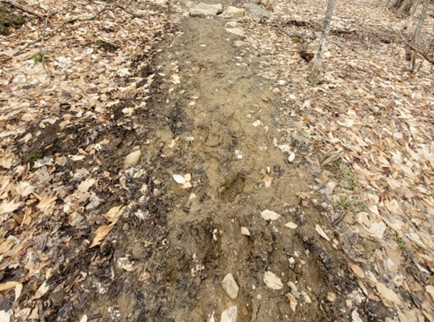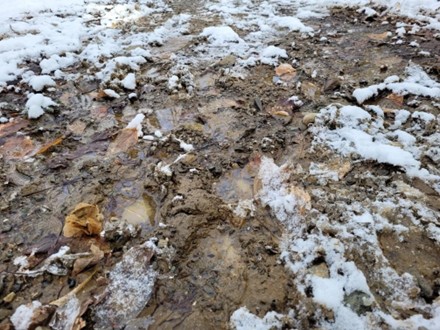By Matthew Cleary

If you’ve ever frozen blueberries, you know what happens when they thaw—what was once firm and plump becomes mushy and fragile. The same thing happens to hiking trails in Quebec every spring. As the snow melts and the topsoil thaws, the ground below remains frozen, preventing proper drainage. This results in a waterlogged mess, making trails vulnerable to damage.
It’s no coincidence that this time of year is called “mud season.” Walking on trails during this period isn’t just unpleasant – it’s harmful. Deep footprints prevent water from draining, forcing hikers to the edges, where they trample plant roots and widen the trail unnecessarily. The result? Increased erosion, long-term damage, and trails that take far longer to recover.
Why Closures Matter
 Much of trail design revolves around water management involving streams and wetlands or rain and snowmelt. We spend a lot of our time imagining where we would want to go if we were a drop of water. Features like dips, trenches, switchbacks, and grade reversals are carefully planned to control erosion and keep trails sustainable. Water flows downhill. If the trail is smooth and crowned, meaning it is higher in the center (think muffin top) or has a slight outslope toward the lower side of the trail (Conventional wisdom is around 5%. 1 2 3) water sheds off the trail or drains into it with minimal impact
Much of trail design revolves around water management involving streams and wetlands or rain and snowmelt. We spend a lot of our time imagining where we would want to go if we were a drop of water. Features like dips, trenches, switchbacks, and grade reversals are carefully planned to control erosion and keep trails sustainable. Water flows downhill. If the trail is smooth and crowned, meaning it is higher in the center (think muffin top) or has a slight outslope toward the lower side of the trail (Conventional wisdom is around 5%. 1 2 3) water sheds off the trail or drains into it with minimal impact
This is not just not for the experience of hikers, but to preserve the wildlife that lives along the trail and the quality of the water that leaves it.
In winter, trails stay intact under the snow. But in spring, as the surface thaws while the deeper soil remains frozen, water gets trapped. If left undisturbed, trails can dry out and regain their stability. But if hikers continue to use them, they degrade rapidly, forming deep ruts that hold water and prevent proper drainage long after the thaw has ended.
Trail closures during this period aren’t arbitrary—they are necessary to protect the trails and the surrounding environment. Repairing the damage caused by early-season hikers diverts our time and resources from maintaining and improving trails for everyone’s benefit. The Massawippi Trail, built by professionals and FREE for the public to enjoy, needs this temporary closure to ensure its long-term sustainability.
Timing and Unpredictability
Knowing exactly when to close and reopen trails isn’t an exact science. Some years, warm weather speeds up the thaw; other times, late snowfalls or heavy rain prolong the process. Even within a single trail system, conditions vary. A sunlit, well-drained section may be ready weeks before a shaded, lower-elevation portion. Just because a trailhead looks dry doesn’t mean the entire trail is in good condition. We monitor the trails closely and reopen them as soon as it’s responsible to do so.
Alternatives for Spring Exploration
Spring closure doesn’t mean you have to stop exploring. The Eastern Townships offer plenty of alternatives, from paved bike paths to scenic boardwalks like the Marais Réal-D.-Carbonneau in Sherbrooke and the Marais de la Rivière-aux-Cerises. Some gravel trails remain open, and trails at higher elevations may close and reopen at different times. There are always options.
Do Your Part
If you see that the Massawippi Trail or the trails at Scowen Park are closed, please respect the closure. Just one person walking on a muddy trail can cause lasting damage—many people make it even worse. These trails exist for everyone, and caring for them now ensures they stay in great condition for the future.
A few weeks of patience each spring means better trails for the rest of the year. Let’s protect them, together.
- (2019, August).
Trailbuilding Guide
Black Sheep Mountain Bike Club
- Heycke, T. (2019, October 26).
Ashland Woodlands & Trails Association Trail Building Steps
Ashland Woodlands & Trails Association
https://www.ashlandtrails.org/trail-tread-building-basics/
- (2008, January).
Building Sustainable Trails: Key Design Elements
Massachusetts Department of Conservation and Recreation’s Greenways and Trails Program
https://www.americantrails.org/resources/building-sustainable-trails-key-design-elements

